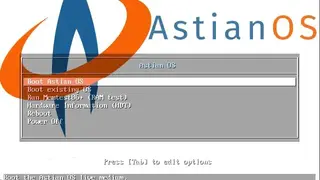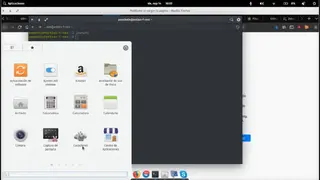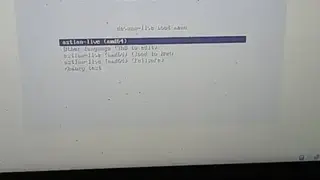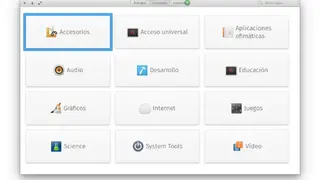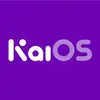
Astian OS
Astian OS is an operating system built by the Astian Foundation using the Firefox OS to provide support for TV, smartphones, and more. It is an open-source project and can be used by anyone free of cost. Its goal is to introduce new advancements in the modern mobile ecosystem and to join the ever-growing list of mobile operating systems developed using JavaScript, CSS, and HTML5. Astian OS is highly scalable and is a great tool that enables interaction with devices via the web. It can run on ChromeBook Acer, Desktop PCs, Devices ARM, and many more.
Astian OS Alternatives
#1 LineageOS
LineageOS is a high-performance Operating system for multiple devices. It is based on Android and enables users to customize the features to their liking. It adds several security tools like Privacy Guard that allow the user to control the behavior of their apps. To improve security, it continuously releases updates to all devices. Furthermore, it provides a highly secure lock screen to block unrestricted access to the device.
LineageOS is currently used by over 20 manufacturers worldwide to power their systems. It has many open source apps that help users in their everyday activities. They can unlock the potential of their device using Unix command-line utilities. It offers APIs to assist Android developers in designing high-quality apps for supported devices.
LineageOS comes preloaded with apps that help users accomplish routine tasks. These apps include Trebuchet, AudioFX, Music, Email, Browser, Recorder, Calculator, Calendar, FlipFlap, Gallery, Messaging, Camera, Contact Directory, Phone, Radio, Files, and more.
#2 CopperheadOS
CopperheadOS is an Operating System for mobile phones that provides enhanced protection to Android devices. It is mainly used as an OS for Google Pixel devices and has its own exclusive store known as the F-Droid store. Among many of its features is the ability to utilize different passwords for opening the lock of the device.
Its primary objective is to increase the security capabilities of the Android OS to shield it from any potential hacks. For this purpose, it adds countless security walls that the hacker has to crush to access the system, which ultimately leads them to give up their pursuit.
CopperheadOS includes tremendous security enhancements as compared to base Android. It uses PaX security updates to increase the shield levels to defend against intruding code. Other key features include verified boot, which protects against any virus that may have gained control of the boot process of the smartphone. It also uses a variant of malloc to optimize the memory structure of the device.
CopperheadOS splits the encryption and unlocking passwords of a device. Smartphone owners can use an easy-to-remember password to access their device; however, typing an incorrect password five times in a row will lead to an automatic restart, after which the encryption password has to be entered correctly to gain access.
#3 GrapheneOS
GrapheneOS is an operating system based on Android for Google Pixel smartphones, including Pixel 3 & 3 XL, 3a & 3a XL, 4 & 4 XL, and more. It uses a robust security model to increase the security and privacy of the system to fight against any threat. The main emphasis of the project is to improve the usability and app compatibility of the device.
It features a verified boot that enhances security and reduces overall threats. It utilizes LTE-only mode to decrease cellular radio attacks by deactivating legacy content. Users can set passwords of up to 64 characters and turn on the Fingerprint unlock to improve efficiency and block unrestricted access to their device.
Furthermore, Fingerprint unlock will automatically turn off the smartphone after five failed attempts. GrapheneOS provides tons of other cool features, including PDF viewer, Authenticated encryption, Powerful app sandbox, Hardened kernel & compiler toolchain, Pin scrambling, Vanadium, and more.
#4 Ubuntu Touch
Ubuntu Touch is a replica of the Ubuntu Operating System for smartphones. It is developed and maintained by the UBports community. It has an appealing UI that is coded in Qt and is greatly enjoyable on touchscreen devices.
Ubuntu Touch provides its users a lot of essential features to help them in their tasks. Each app within the OS will require to be opened via a lock screen whenever necessary. The welcome screen shows the amount of activity on the smartphone. It displays several things, such as the current status of the user, past actions, and all the activities performed in the previous month.
The Operating System is pre-loaded with major applications, including a terminal, full-fledged calculator, clock, file manager, e-mail app, and more. The team behind the OS regularly releases new applications to enhance the user experience. Furthermore, most of the applications can also run on the desktop, such as Weather, Browser, Notes, Reminders, Clocks, Terminal, and more.
#5 Android Nougat
Android Nougat is the seventh iteration released by Google for the Android Operating System. It came with several major features, one of which was the ability to view multiple apps side-by-side simultaneously. This characteristic allowed the user to accomplish various tasks in a short time. Other features that came with this version were improved power-saving functionality and inline response to notifications. It uses OpenJDK, which enables it to utilize the highly efficient Vulkan graphics API.
Android Nougat improved the User Experience by revamping the notifications bar. It also updated the emoji library and enabled the user to use multiple languages simultaneously. The most liked quality was the Multi-window view, making it easier to swap between apps by tapping the screen two times. This feature made multitasking much easier than before.
The Operating System provided 3D textures in games, thanks to the Vulkan API, which enhances the sharpness of the display. Another top feature is the VR mode which allowed the user to experience Virtual Reality like never before. Android Nougat preserves smartphone battery through Doze mode. This mode instructs the device to consume less power when it’s not being used. It also introduced more features such as Custom Quick Settings that lets the user change places of icons and Notification Direct Reply that enables them to respond to received messages.
#6 Android 10
Android 10 is the tenth upgrade available for devices running the Android Operating System. Its main talking point is the gesture system and animations. The gesture system allowed the user to accomplish various tasks by performing gestures. Swiping from the edge of the screen resulted in the opening of the previous display, while Swipe in the upper direction leads to the home screen. The user could also launch the Google Assistant by doing a diagonal swap.
The OS introduced a dark mode that would change the GUI into black. It enhanced the device’s security by enabling the user to prevent the apps from accessing information such as location data and deciding which app should be allowed to run in the background.
Besides improving security, Android 10 features a Live caption, which automatically shows the text of any video running on the device. It also captions audio replies, videos, and podcasts without requiring an Internet connection. Users can quickly respond to messages through Smart Reply, an intelligent recommendation system that shows actions. Other features included within the OS are Sound Amplifier, Family Link, Focus mode, Location controls, Security Updates, and more.
#7 KaiOS
KaiOS is a Linux-based Operating System for phones with keypads. It enriches devices with several high-profile functionalities like 4G, GPS, VoLTE, and LTE E. Battery timing of non-touchscreen devices is significantly improved by providing a highly efficient UI that eats less battery and memory. It features apps based on HTML5 and regularly releases over-the-air updates for all devices.
By default, KaiOS comes bundled with popular apps like Facebook and Youtube. It also includes a marketplace similar to the Google Play Store called KaiStore that contains tons of app that the user can download. KaiStore currently has over 500 apps, with more regularly being added to its collection. Lastly, the OS has been optimized to run seamlessly on devices with as little as 256 MB of RAM.
#8 Android Jelly Bean
Android Jelly Bean is the tenth upgrade for mobiles using the Android Operating System. It was released in three cycles, with version 4.1 being the first and version 4.3.1 being the final. Version 4.1 added significant improvements, including speed, responsiveness, and changes to the notification functionality. The next update was released in Version 4.2, which further enhanced the functionality of the OS by providing widgets for lock screen, screen savers, and instant settings.
Android Jelly Bean as a whole introduces massive improvements to the Android Platform. It offers Restricted profiles for tablets to allow the user to control the limitation of apps at the office and residence. This feature enables parents/guardians to use parental controls for restricting the activities of their kids, whereas retailers can transform their tablet device into a full-fledged kiosk.
Users can connect fitness sensors with their devices thanks to Bluetooth Smart support. This feature consumes low power and supports major sensors like Runtastic, Fitbit, Google Fit, RunKeeper, and others, enabling increased efficiency for smartphones or tablets. The Operating System also adds autocompletion for the dial pad, which recommends numbers that are being typed. Lastly, People who speak Hebrew and Arabic will find better support for their languages.
#9 Android Lollipop
Android Lollipop is the successor to Android KitKat and adds major changes to the Android mobile operating system. It was released in several iterations, with version 5.5.1 being the last to launch. It improved the visual appeal of the User Interface through the usage of Material Design, which gave it a paper-like style. Besides UI, Google enhanced the notification system by allowing users to interact with messages on the lock screen. Battery performance was also improved along with applications to give a seamless experience.
Apart from the Phone and Tablet, Android Lollipop also features support for Cars, TV, and watches. It saves users’ progress so that they can resume their activity from any device. The OS allows users to enable/disable devices that can display notifications and restrict specific contacts from sending messages.
Android Lollipop includes a battery saver functionality that increases the battery strength to 90 minutes before dying. It also shows important information such as the time left before the phone turns off and the duration for maximum charging. Lastly, users can grant access to the device to their friends by creating separate accounts for them to log in.
#10 Android KitKat
Android KitKat is an operating system for mobile devices released to the public on September 3, 2013. Its main goal is to increase the efficiency of the operating system to run comfortably on entry-level devices. It adds several enhancements, including an attractive User Interface along with high performance and other improvements. Users can achieve many tasks such as sending messages, finding directions or starting a song through Voice Commands.
Any media playing on the device can be interacted with on the lock screen, which shows the song’s name, album, cover, and actions like pause, play and stop. This feature allows the user to switch to the next song within the album or stop it entirely by touching their lock screen. The Operating system introduces an Immersive mode which allows the reader to dive deeper into their book by removing the status bar and buttons from the interface.
Android KitKat enables the user to interact with several apps simultaneously with faster multitasking. Users can bring up all the apps running in the background, which are displayed in sequential order, and their names so that the user can open the required one, perform the necessary action and then jump back to the previous app without any delays.
#11 BlackBerry OS
BlackBerry OS is the official and the only operating system for Blackberry devices. It enables multitasking and delivers complete support for input devices used in the BlackBerry phones, such as the trackball, touchscreen, trackwheel, and trackpad. The OS provides all the necessary apps to aid the user in everyday tasks. These apps include contacts, calendar, notes, tasks, corporate email, Novell Groupwise email, and more.
The current version of the BlackBerry OS is BlackBerry 10, which introduces key improvements to enhance the user experience. It offers BlackBerry Flow to enable the user to move from one app to another instantly. Another great feature is BlackBerry Hub which gathers everyday activities and displays them on a single screen to help users manage them with great ease. The OS also includes BlackBerry Hub to allow users to view the unread messages from their social media accounts, email, and text messages and then quickly resume their previous tasks.
#12 Maru OS
Maru is a lightweight, context-aware OS that allows you to use your mobile device as a fully capable Computer System. It unlocks the full potential of the mobile device to make it easy for you to perform daily tasks with maximum efficiency. It is a unique Operating System that provides everyone with a single, context-aware device to transform their lives. It is designed using Android Oreo and is free from bloatware to ensure high speed and free up much-needed space for important apps.
The OS offers top-notch multitasking along with desktop productivity to reduce the time taken to fulfill complex tasks. It runs on top of Debian Linux to help everyone customize it according to requirements. It is easy to set up, and you merely have to connect the phone with an HDMI display, after which the OS will start the detection process and be ready for usage within 5 seconds. The next step involves plugging a mouse and a Bluetooth keyboard. Finally, it is ready for work, and you can start enjoying its features.
#13 Plasma Mobile
Plasma Mobile is an open-source user interface for mobile phones that comes with dozens of apps to help you with daily tasks. It includes apps that help with everyday activities like NeoChat, Alligator, GCompris, Kontrast, Peruse, Spacebar, Elisa, Okular, Calindori, Angelfish Web Browser, Vvave, and many more. It is developed using a Linux distribution to transform your mobile phone it a fully hackable device. It uses state-of-the-art technology like Qt, Plasma Shell, and KDE Frameworks to deliver the best experience possible.
Plasma Mobile employs popular software tools to speed up the performance and efficiency at which tasks are performed. It relies on Ofono to power its telephone solution and delivers communication utilities using Telepathy. It uses a Pulseaudio sound system to make the audio smooth and pleasant to hear. Plasma Mobile learns from your activities and adapts to them so you can quickly execute the required actions without repeating the effort. Everyone can customize it by adding widgets, changing the color schemes, fonts, and many more options.
#14 postmarketOS
postmarketOS is a powerful, open-source operating system for mobile phones developed using the Alpine Linux distribution. The source code for the OS is freely available on GitLab. It can run various Wayland and X-based UI’s like XFCE, Plasma Mobile, and GNOME 3. The developers released further updates, which adds support for more user interfaces including Phosh, and unity8. The goal of the OS is to offer a ten-year lifecycle for smartphones, in which they would receive regular updates featuring better functionality and addressing flaws. postmarketOS can also run Docker, but the device should have cgroups kernel and the required settings turned on.
#15 OpenThos
OpenThos is an open-source, fully-featured operating system developed using the Android x-86 architecture. It offers many features similar to any other operating using the Android x-86 architecture. What makes it unique is the open-source nature which is something other similar OSes lack. You can find and go through the source code on GitHub and the official webpage. Its features include end-to-end encryption, lightweight GUI, a strong security system, enhanced PC performance, application isolation, and permission control, and more.
It has a UEFI Boot Manager, which supports popular desktop operating systems like Mac OS X, Windows, and Linux. It can also synchronize with computer systems using the mentioned Operating Systems. OpenThos is free from lags and delivers a 60 FPS drawing frame rate. It has its own native task manager, file explorer, window manager, and more tools. The OS fixes the issues present in many modern desktop operating systems. Lastly, you can run it alongside Wear, mobile phones, and any other device running on Android.
#16 Tizen OS
Tizen OS is a full-fledged standards-based, open-source software platform capable of running on various devices like TVs, smartphones, tablets, and more. It addresses the requirements of every person with a stake in the mobile ecosystem, such as software application developers, manufacturers, mobile operators, and software vendors. It is designed by a community of developers and is freely available under the open-source license. You can also become a part of this effort and show your support.
It comes in several profiles to fulfill the needs of different industries. The profiles include Tizen Wearable, Tizen IVI, Tizen TV, and Tizen Mobile. With the latest release of Tizen 3.0, every profile uses a shared infrastructure named Tizen Common. Device manufacturers have the freedom to sue one of the available profiles or use Tizen Common to build a new profile from scratch. Mobile operators can collaborate with device partners to develop a customized operating system targeted towards a specific user base.
#17 HarmonyOS
HarmonyOS is a cutting-edge operating system that enables better collaboration and interconnection between smart devices. It offers fast, free from latency interaction that is suitable in all use cases. It unlocks communication among a long list of devices like Televisions, earphones, smartphones, and automobile head units. It has a resource-sharing network in place under which all devices work closely and contribute resources to provide the best experience for everyone. Application developers can start building apps using the Huawei DevEco Studio, an all-in-one platform with all the features to make it easy to develop state-of-the-art apps.
